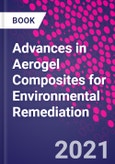Advances in Aerogel Composites for Environmental Remediation presents both contextual information about
aerogels and details about their application in environmental remediation. A wide variety of aerogels are discussed, ranging
from common to advanced and from natural to synthetic. By exploring ongoing research and developments in the environmental
remediation technologies using aerogel and its composites, this book addresses common day-to-day environmental problems
and presents solutions to the use of aerogel materials. The chapters discuss fabrication of various aerogel composites, along
with their design and applications toward different environmental remediation technologies. Additionally, the properties and
advantages of aerogels are compared and contrasted to those of traditional materials.
Given the consistent increase in environmental pollution, there is an urgent need to explore new materials for advances in remediation
technology. Advances in Aerogel Composites for Environmental Remediation brings researchers and practitioners
in the fields of environmental remediation, environmental science, and engineering to the forefront of remediation technologies
with a thorough breakdown of the benefits of and techniques relevant to aerogel composites.
Please Note: This is an On Demand product, delivery may take up to 11 working days after payment has been received.
Table of Contents
1. Aerogel and its composites: Fabrication and properties2. Natural aerogels for pollutant removal
3. Biomedical applications of aerogel
4. Carbon aerogel composites for gas sensing
5. Conducting polymer-based aerogels for environmental remediation
6. Aerogels in photocatalysis
7. Aerogels for water borne bodies purification
8. Aerogel and its composites for heavy metal detection, dye adsorption,
and photocatalysis
9. Metal and metal oxides aerogels in purification systems
10. Adsorptive removal of pollutants using aerogels and its composites
11. Aerogels for as microbial disinfectant
12. Carbon aerogel for environmental remediation
13. Aerogels in the environment protection
14. Carbon-based conducting polymers aerogels and their sensing behavior
15. Heavy metals scavenging using multidentate/multifunctional aerogels
and their composites
16. Applications of nanocarbon-based aerogels in purifying industrial wastewater
17. Bio-based aerogels for environmental remediation problems
18. Bio-based aerogels and their environment applications: an overview
19. Aerogel applications and future aspects
Index
Authors
Aftab Aslam Parwaz Khan Assistant Professor, Chemistry Department, Center of Excellence for Advanced Materials Research, King AbdulazizUniversity, Jeddah, Saudi Arabia. Dr. Aftab Aslam Parwaz Khan is presently working as an Assistant Professor in the Center of Excellence for Advanced Materials Research, King Abdulaziz University, Jeddah, Kingdom of Saudi Arabia. He earned his Ph.D. in Chemistry from Aligarh Muslim University, Aligarh, India in 2011. He has authored 3 books, 15 chapters and more than 130 research papers published in journals of international repute. He is also an Editorial Board Member, as well as a reviewer of many reputed international journals. His research encompasses all aspects of nanomaterials, synthesis, and characterization as well as application in chemical sensing, biosensing environmental remediation of pollution, and drug delivery system for mechanistic and interaction studies using a wide range of spectroscopic techniques and thermodynamic parameters. Mohammad Omaish Ansari Center of Nanotechnology, King Abdulaziz University, Jeddah, Saudi Arabia. Dr. Mohammad Omaish Ansari is currently working as an Assistant Professor in the Center of Nanotechnology, King Abdulaziz University, Kingdom of Saudi Arabia. He obtained his PhD. in the field of Electrically Conducting Polymers from the Department of Applied Chemistry, Aligarh Muslim University, India in 2012. Before joining King Abdulaziz University, he also worked as Assistant Professor at Yeungnam University, South Korea from 2013-2015. Apart from research activities, he has also taught various courses on nanocomposites and conducting polymers to graduate and undergraduate students. Dr. Ansari has published sixty papers in refereed journals of international repute, contributed five book chapters, and edited one book. His research interests include conducting polymer synthesis, properties, and device applications, chemical and biosensors, polymer nanocomposites, and polyblends besides having an interest in environmental issues and energy storage devices. Anish Khan Assistant Professor in Chemistry Department, Center of Excellence for Advanced Materials Research, King Abdulaziz University, Jeddah 21589, Saudi Arabia.
Dr. Anish Khan is currently working as Assistant Professor in Chemistry Department, Centre of Excellence for Advanced Materials Research (CEAMR), Faculty of Science, King Abdulaziz University, Jeddah, Saudi Arabia. Completed Ph.D. from Aligarh Muslim University, India in 2010. Completed Postdoctoral from School of Chemical Sciences, University Sains Malaysia (USM) in Electroanalytical chemistry in 2010. Working in the field of synthetic biosensor, polymer composites, organic-inorganic electrically conducting nanocomposites. More than 200 research articles, 70 book chapters 30 books published in referred international publisher and more than 20 international conferences/ workshop. More than 30 research projects completed. Editorial board member of more than 11 international journals. Member of American Nano Society.
Abdullah M. Asiri Chemistry Department, Center of Excellence for Advanced Materials Research, King Abdulaziz University,Jeddah, Saudi Arabia. Prof. Abdullah M. Asiri is the Head of the Chemistry Department at King Abdulaziz University since October 2009 and he is the founder and the Director of the Center of Excellence for Advanced Materials Research (CEAMR) since 2010 till date. He is the Professor of Organic Photochemistry. His research interest covers color chemistry, synthesis of novel photochromic and thermochromic systems, synthesis of novel coloring matters and dyeing of textiles, materials chemistry, nanochemistry and nanotechnology, polymers and plastics. A major achievement of Prof. Asiri is the discovery of tribochromic compounds, a class of compounds which change from slightly or colorless to deep colored when subjected to small pressure or when grind. This discovery was introduced to the scientific community as a new terminology published by IUPAC in 2000. This discovery was awarded a patent from European Patent office and from UK patent. He is also a member of the Editorial Board of various journals of international repute. He is the Vice- President of Saudi Chemical Society (Western Province Branch). He holds four USA patents, more than 800 Publications in international journals, seven book chapters, and ten books








